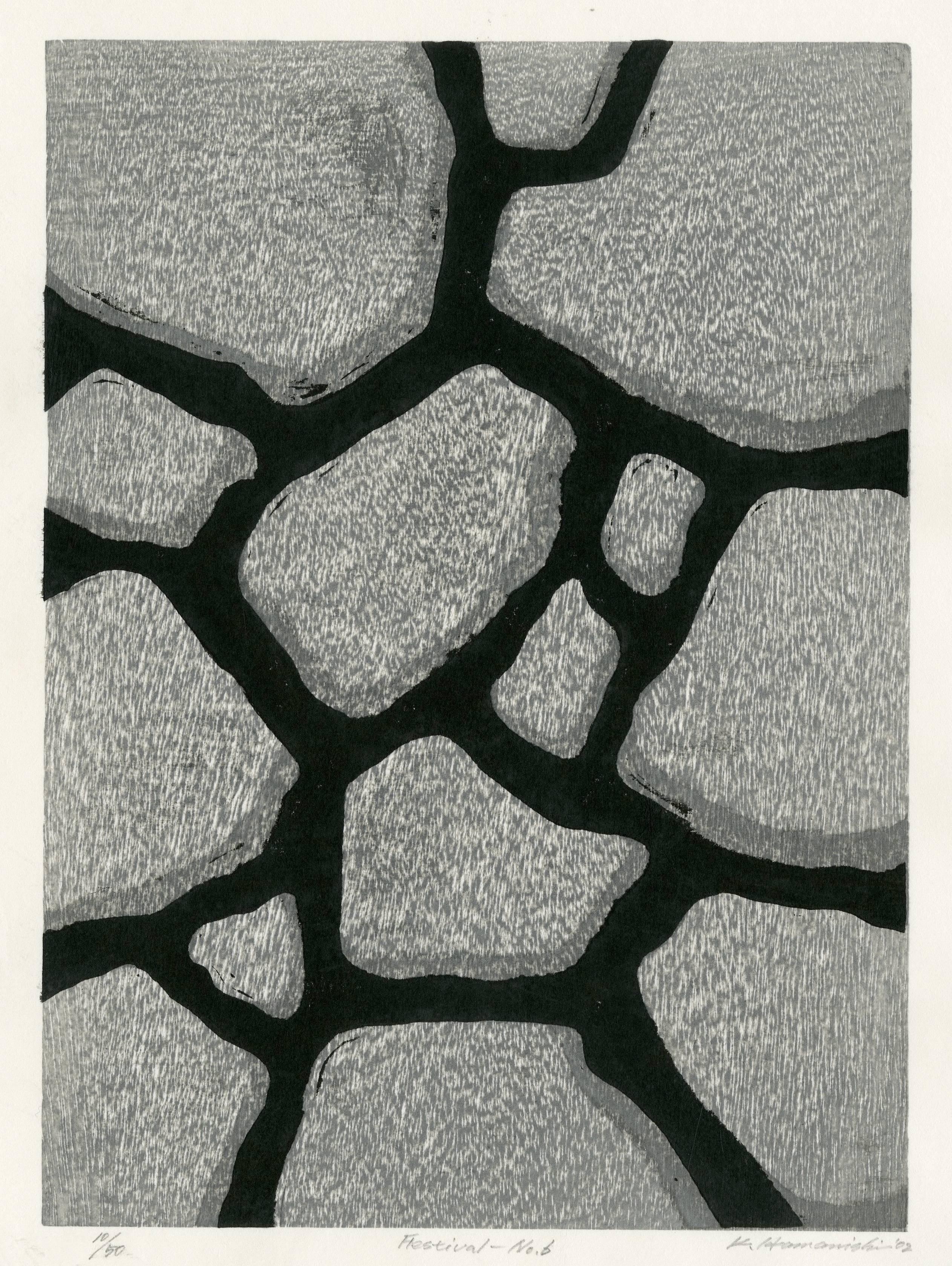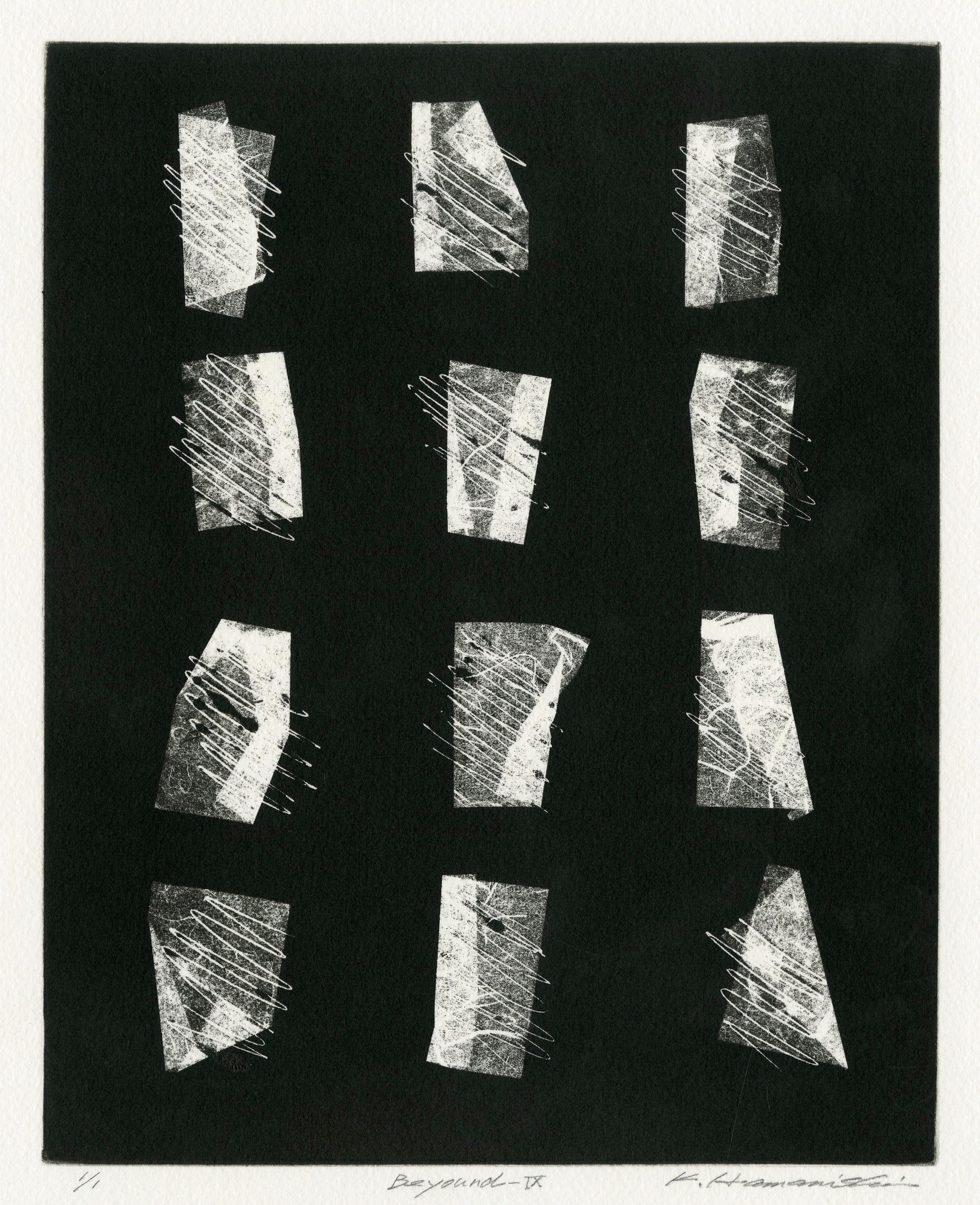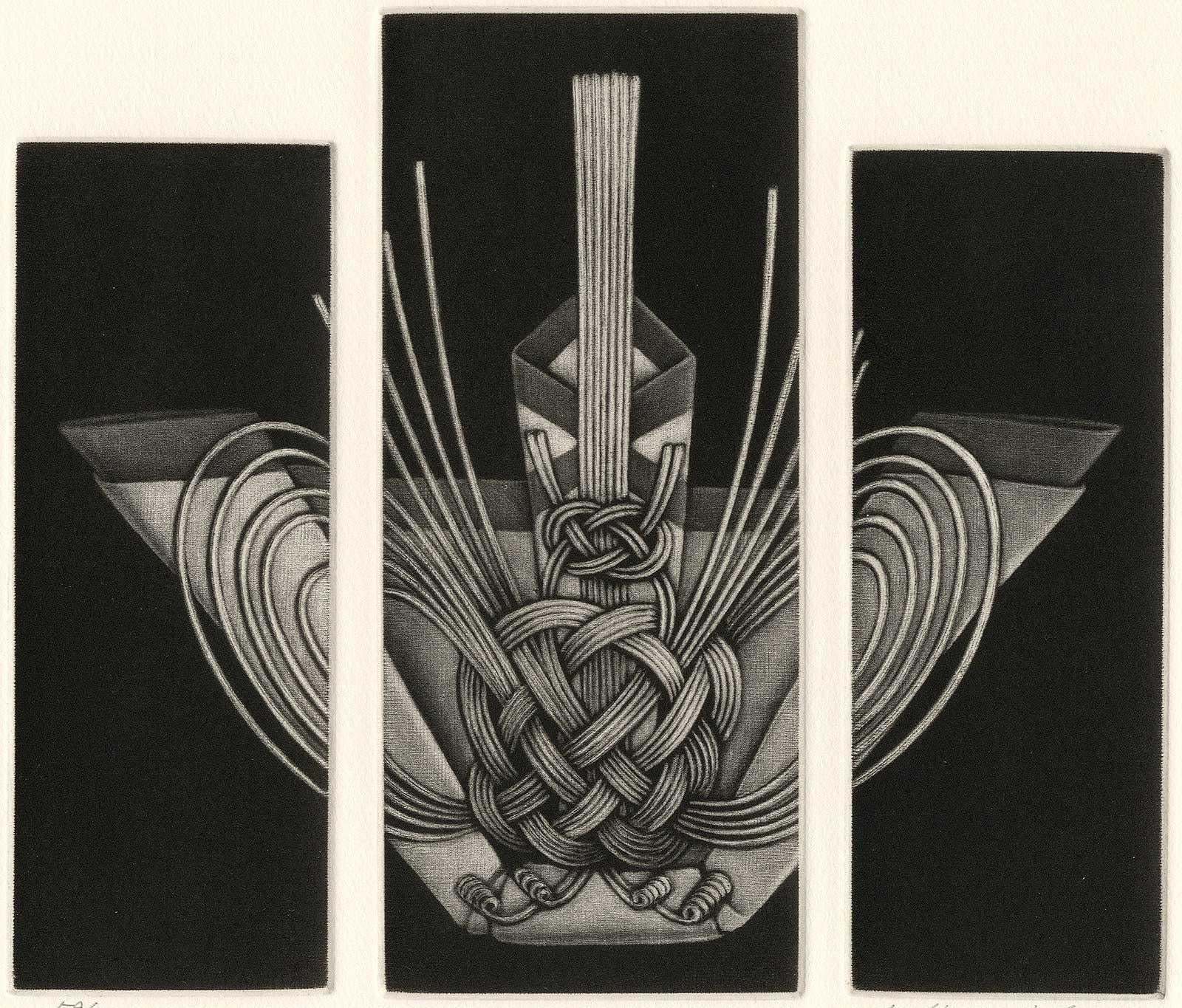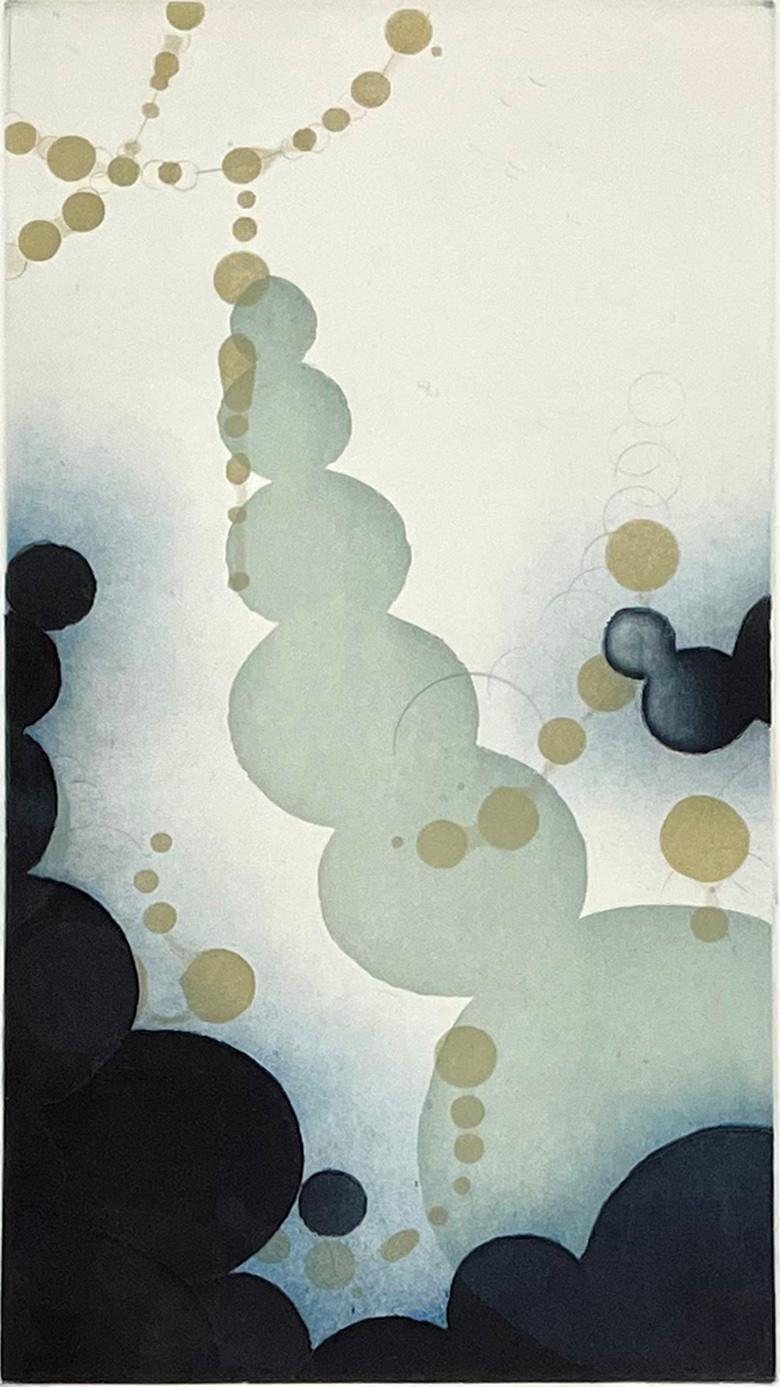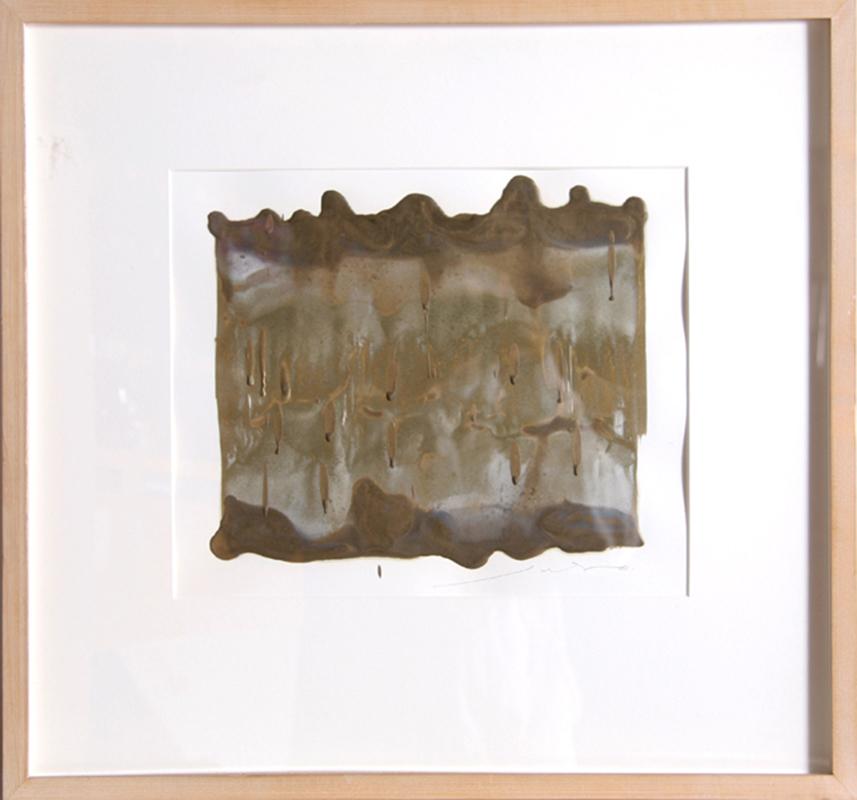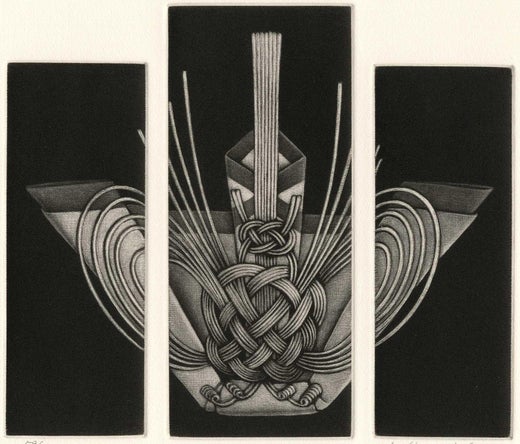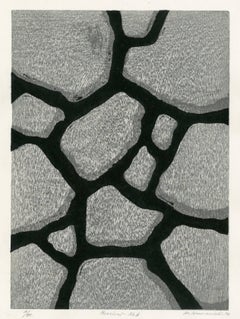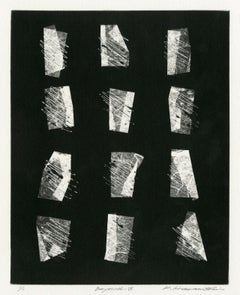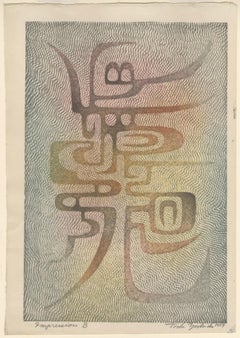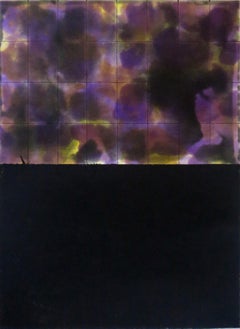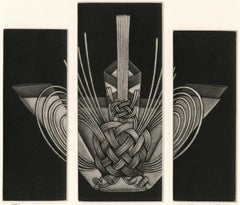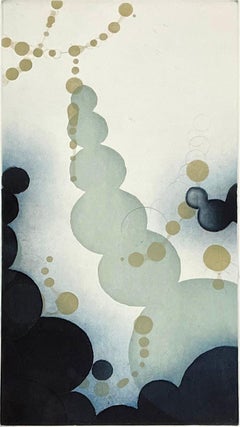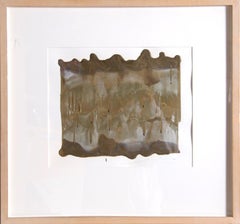Items Similar to Festival No. 6
Want more images or videos?
Request additional images or videos from the seller
1 of 8
Katsunori HamanishiFestival No. 62002
2002
$650
£497.14
€568.92
CA$925.13
A$1,001.64
CHF 532.53
MX$12,080.52
NOK 6,696.84
SEK 6,243.36
DKK 4,249.13
About the Item
Festival No. 6
Color woodblock, 2002
Signed, titled and numbered in pencil (see photos)
Edition: 50 (10/50), see photo
Provenance:
Ninion and Sheldon Landy Collection, Donors to Art Inst. of Chicago
Hamanishi Exhibition, Oct. 12, 2013-January 5, 2014
Reference: Hamanishi Small 98
Condition: Excellent
Sheet: 12 1/4 x 9 1/8";
Image 10 1/2 x 7 1/2"
Katsunori Hamanishi
Born: 1949, Hokkaido
Medium: Mezzotint, with relief printing and metallic foil. Also a few woodblocks
Hamanishi studied painting and graduated from Tokai University with a degree in Art, in 1973. Since then, he has been living in the Tokyo area, where his primary focus is printmaking. Mezzotint is a variation of intaglio printing--an exacting and laborious process whereby ink is transferred from below the surface of the plate by use of a press. First, the entire copper plate is indented with a toothed steel rocker tool. Worked in all directions, this creates an even finely-grained texture over the surface of the plate. Each pit will hold ink and were the plate inked at this stage, it would print almost solid black.
To create the design the artist smoothes out some of the pits with a burnisher so they will hold less ink. Where highlights are required the plate is burnished and polished quite smooth. A wide range of tones are possible in mezzotint and the process can usually be recognized by a light design on a velvety black background. Hamanishi is internationally known for his mastery of this medium. He creates images with both subtle detail and dynamic composition that explore spatial relationships.
His genius is in balancing calm and meditative qualities with the energetic tensions of inanimate and natural objects. Early work had such things as pipes and branches wrapped with cloth, later rope, then straw. When he moved to a more rural area, rice fields became a common element. He has also been exploring the use of color and metallic leaf in his artwork. In 2005 Mr. Hamanishis began the Haze series exploring more abstract themes using the subtle differences between matte and black inks done in mezzotint and relief printing.
There is always a sense of mystery and intrigue in the complex mezzotint prints that come from Hamanishi’s deft hands. They compel the viewer to do a slow, thoughtful examination in order to fully absorb the vision the artist intends.
Exhibitions:
Worcester Art Museum, Massachusetts --2 person show with Hamaguchi
Ibiza Biennial, Spain--Grand Prize
Original Colored Graphic Print Triennial, Switzerland--Grand Prize
Cabo Frio International Print Biennial, Brazil--Grand Prize
CWAJ Print Show, Tokyo--Art Grant winner
Republic of China Print Exhibit--Gold Medal
Graphic Arts Council, Achenbach Foundation, San Francisco--commissioned print
Art Institute of Cleveland
University of Alberta, Edmonton, Canada--visiting artist
Shun-yo-Kai, Tokyo--prize winner
Bhara Bhavan International Print Biennale, India
Ren Brown Collection, Bodega Bay
Collections:
The British Museum, London
Metropolitan Museum of Art, New York
Museum of Modern Art, New York
Art Institute of Chicago
National Museum of Art, Osaka
Library of Congress, Washington, DC
Art Gallery of New South Wales, Australia
Philadelphia Museum of Art, Pennsylvania
Hokkaido Museum of Modern Art, Sapporo
Krakow National Museum, Poland
Museum of New Zealand, Te Papa Tongarewa
Cleveland Museum of Art
Achenbach Foundation for Graphic Arts, San Francisco
- Creator:Katsunori Hamanishi (1949, Japanese)
- Creation Year:2002
- Dimensions:Height: 12.25 in (31.12 cm)Width: 9.13 in (23.2 cm)
- Medium:
- Movement & Style:
- Period:
- Condition:Excellent. Slight crimp lower left corner of sheet, not affecting the image.
- Gallery Location:Fairlawn, OH
- Reference Number:Seller: UK22031stDibs: LU14013621272
Katsunori Hamanishi
Katsunori Hamanishi was born in 1949 on Hokkaido island, Japan's second-largest island. In 1973, he finished his studies at Tokai University in Kanagawa prefecture. In 1987 and 1988, he studied at the University of Pennsylvania through a grant by a US cultural institution. At that time, Hamanishi was already a respected artist, who had received prizes at renowned international exhibitions.
About the Seller
5.0
Recognized Seller
These prestigious sellers are industry leaders and represent the highest echelon for item quality and design.
Gold Seller
Premium sellers maintaining a 4.3+ rating and 24-hour response times
Established in 1978
1stDibs seller since 2013
831 sales on 1stDibs
Typical response time: <1 hour
Associations
International Fine Print Dealers Association
- ShippingRetrieving quote...Shipping from: Fairlawn, OH
- Return Policy
More From This Seller
View AllFestival No. 6
By Katsunori Hamanishi
Located in Fairlawn, OH
Festival No. 6
Color woodblock, 2002
Signed, titled and numbered in pencil (see photos)
Edition: 50 (10/50), see photo
Provenance:
Ninion and Sheldon Landy Collection, Donors to Art Inst. of Chicago
Hamanishi Exhibition, Oct. 12, 2013-January 5, 2014
Reference: Hamanishi Small 98
Condition: Excellent
Sheet: 12 1/4 x 9 1/8";
Image 10 1/2 x 7 1/2"
Katsunori Hamanishi
Born: 1949, Hokkaido
Medium: Mezzotint, with relief printing and metallic foil. Also a few woodblocks
Hamanishi studied painting and graduated from Tokai University with a degree in Art, in 1973. Since then, he has been living in the Tokyo area, where his primary focus is printmaking. Mezzotint is a variation of intaglio printing--an exacting and laborious process whereby ink is transferred from below the surface of the plate by use of a press. First, the entire copper plate is indented with a toothed steel rocker...
Category
Early 2000s Abstract Abstract Prints
Materials
Woodcut
Beyound (sic) - IX
By Katsunori Hamanishi
Located in Fairlawn, OH
Beyond (sic) - IX
Mezzotint, n.d.
Signed, titled and numbered in pencil (see photos)
Edition: Unique impression (i/I)
Ninion and Sheldon Landy were major collectors of Hamanishi's works. They donated a large group of his mezzotints to Art Institute of Chicago, which formed the core of the exhibitions of his works at AIC in 2014 and again in 2019.
Condition: excellent
Plate/Image size: 9.75 x 7.75 inches
Sheet size: 12 1/2 x 9 5/8 inches
Provenance: Ninion and Sheldon Landy, Hamanishi's patrons
EXTREMELY RARE-UNIQUE
Katsunori Hamanishi
Born: 1949, Hokkaido
Medium: Mezzotint, with relief printing and metallic foil. Also a few woodblocks
Hamanishi studied painting and graduated from Tokai University with a degree in Art, in 1973. Since then, he has been living in the Tokyo area, where his primary focus is printmaking. Mezzotint is a variation of intaglio printing--an exacting and laborious process whereby ink is transferred from below the surface of the plate by use of a press. First, the entire copper plate is indented with a toothed steel rocker tool. Worked in all directions, this creates an even finely-grained texture over the surface of the plate. Each pit will hold ink and were the plate inked at this stage, it would print almost solid black.
To create the design the artist smoothes out some of the pits with a burnisher so they will hold less ink. Where highlights are required the plate is burnished and polished quite smooth. A wide range of tones are possible in mezzotint and the process can usually be recognized by a light design on a velvety black background. Hamanishi is internationally known for his mastery of this medium. He creates images with both subtle detail and dynamic composition that explore spatial relationships.
His genius is in balancing calm and meditative qualities with the energetic tensions of inanimate and natural objects. Early work had such things as pipes and branches wrapped with cloth, later rope, then straw. When he moved to a more rural area, rice fields became a common element. He has also been exploring the use of color and metallic leaf in his artwork. In 2005 Mr. Hamanishis began the Haze series exploring more abstract themes using the subtle differences between matte and black inks done in mezzotint and relief printing.
There is always a sense of mystery and intrigue in the complex mezzotint prints that come from Hamanishi’s deft hands. They compel the viewer to do a slow, thoughtful examination in order to fully absorb the vision the artist intends.
Exhibitions:
Worcester Art Museum, Massachusetts --2 person show with Hamaguchi
Ibiza Biennial, Spain--Grand Prize
Original Colored Graphic Print Triennial, Switzerland--Grand Prize
Cabo Frio International Print Biennial, Brazil--Grand Prize
CWAJ Print Show, Tokyo--Art Grant winner
Republic of China Print Exhibit--Gold Medal
Graphic Arts Council, Achenbach Foundation, San Francisco--commissioned print
Art Institute of Cleveland
University of Alberta, Edmonton, Canada--visiting artist
Shun-yo-Kai, Tokyo--prize winner
Bhara Bhavan International Print Biennale, India
Ren Brown...
Category
1980s Abstract Abstract Prints
Materials
Mezzotint
Impression B
By Toshi Yoshida 1
Located in Fairlawn, OH
Impression B
Color woodcut, 1959
Signed and dated lower right (see photo)
Titled lower left (see photo)
A trial proof, prior to the edition of 100, signed and numbered
Condition: Excellent
Image size: 14 1/2 x 9 3/4 inches
Provenance: Estate of the artist
by decent to his heirs
"Printmaker and painter Toshi Yoshida was born on July 25, 1911, into the respected Yoshida family of artists of Tokyo, Japan. Father Hiroshi was a celebrated landscape painter and printmaker, and mother Fujio established herself as the first female Yoshida artist as well as an Abstract artist later in her career. Younger brother Hodaka was an Abstract printmaker whose style, completely separate from his family's historic traditional bent, later influenced Toshi. Hodaka's wife Chizuko would become a pioneering female Japanese artist whose own exploration of Surrealism and Abstraction challenged the status quo. Toshi, however, as the eldest sibling, was expected to follow in his father's footsteps, and from an early age he was trained by Hiroshi in his studio.
Unable to attend formal schooling due to the polio-induced paralyzation of his leg, Toshi would instead help with his family's printmaking studio and go on sketching trips with Hiroshi. As he got older, these trips would include India and Southeast Asia, working from morning to night taking night trains to get from one destination to another. Among Toshi's favorite subjects were the animals he discovered along the way. However, these trips ended as Japan entered military dictatorship in the mid 1930s, and artists whose work showed signs of Western influence were barred from exhibiting. At this time, Toshi left Japan for China and Korea, where he would remain for the duration of the war. He stuck to patriotic themes to remain in business, and after the end of World War II, as Japan struggled to recover from wartime economic depression, he earned his living creating traditional Japanese woodcut landscapes...
Category
1950s Abstract Abstract Prints
Materials
Woodcut
Impression B
By Toshi Yoshida 1
Located in Fairlawn, OH
Impression B
Color woodcut, 1959
Signed and dated lower right (see photo)
Titled lower left (see photo)
A trial proof, prior to the edition of 100, signed and numbered
Condition: Excellent
Image size: 14 1/2 x 9 3/4 inches
Provenance: Estate of the artist
by decent to his heirs
"Printmaker and painter Toshi Yoshida was born on July 25, 1911, into the respected Yoshida family of artists of Tokyo, Japan. Father Hiroshi was a celebrated landscape painter and printmaker, and mother Fujio established herself as the first female Yoshida artist as well as an Abstract artist later in her career. Younger brother Hodaka was an Abstract printmaker whose style, completely separate from his family's historic traditional bent, later influenced Toshi. Hodaka's wife Chizuko would become a pioneering female Japanese artist whose own exploration of Surrealism and Abstraction challenged the status quo. Toshi, however, as the eldest sibling, was expected to follow in his father's footsteps, and from an early age he was trained by Hiroshi in his studio.
Unable to attend formal schooling due to the polio-induced paralyzation of his leg, Toshi would instead help with his family's printmaking studio and go on sketching trips with Hiroshi. As he got older, these trips would include India and Southeast Asia, working from morning to night taking night trains to get from one destination to another. Among Toshi's favorite subjects were the animals he discovered along the way. However, these trips ended as Japan entered military dictatorship in the mid 1930s, and artists whose work showed signs of Western influence were barred from exhibiting. At this time, Toshi left Japan for China and Korea, where he would remain for the duration of the war. He stuck to patriotic themes to remain in business, and after the end of World War II, as Japan struggled to recover from wartime economic depression, he earned his living creating traditional Japanese woodcut landscapes...
Category
1950s Abstract Abstract Prints
Materials
Woodcut
Untitled
By Shoichi Ida
Located in Fairlawn, OH
Untitled
molded mud-dried paper with collage elements, 1996
Signed and dated lower edge (see photo)
Annotated and titled verso
Sheet size: 24 x 7 inches
Provenance: Ralph Drake, fir...
Category
1990s Abstract Abstract Drawings and Watercolors
Materials
Mixed Media
Untitled
By Shoichi Ida
Located in Fairlawn, OH
Untitled
molded mud-dried paper with collage elements, 1996
Signed and dated lower edge (see photo)
Annotated and titled verso
Sheet size: 24 x 7 inches
Provenance: Ralph Drake, fir...
Category
1990s Abstract Abstract Drawings and Watercolors
Materials
Mixed Media
You May Also Like
96-C-1
Located in San Francisco, CA
Artist: Yutaka Yoshinaga – Japanese (1948- )
Title: 96-C-1
Year: 1996
Medium: Color spit bite aquatint with drypoint and hard ground etching.
Image si...
Category
1990s Abstract Geometric Abstract Prints
Materials
Etching, Aquatint
Mizuhiki
By Katsunori Hamanishi
Located in New Orleans, LA
"Mizuhiki" is an exclusive publication by Stone + Press in an edition of 100.
Katsunori Hamanishi was born in 1949 on Hokkaido island - Japan's second largest island. In 1973 he fi...
Category
1990s Contemporary Abstract Prints
Materials
Mezzotint
$82 Sale Price
25% Off
Origin-Beginning-6 (9/20)
By Seiko Tachibana
Located in Palm Springs, CA
One of seven images from the Origin-Beginning series.
Seiko Tachibana was born in Japan and completed her Masters of Art Education at Kobe University, Japan.
Her distinctive work b...
Category
21st Century and Contemporary Abstract Abstract Prints
Materials
Etching, Aquatint
$560 Sale Price
20% Off
Untitled IV, Abstract Encaustic and Sand Painting on Canvas by Juhachiro Takada
By Juhachiro Takada
Located in Long Island City, NY
Artist: Juhachiro Takada
Title: Untitled IV
Medium: Encaustic, Sand on Canvas, Signed in pencil
Paper Size: 10.5 x 12.5 inches
Frame Size: 19.5 x 20.5 inches
Category
1980s Abstract Abstract Paintings
Materials
Encaustic
field of origin III-b (10/10), by Seiko Tachibana
By Seiko Tachibana
Located in Palm Springs, CA
Medium: Etching and aquatint
Year: 2005
Image Size: 9 x 36 inches
Sheet Size: 48 x 16 inches
A strong abstract image using a mix of intaglio techniques, 4 feet in height. This is a ...
Category
Early 2000s Abstract Abstract Prints
Materials
Mixed Media, Etching, Aquatint
Horizontal Alignment
By Kunihiko Maehara
Located in Fairfield, CT
When a simple vertical line finds itself in the midst of accidental organic chaos, a sense of directionality and stability is introduced. The line itself can act as a tool used to di...
Category
21st Century and Contemporary Abstract Abstract Paintings
Materials
Canvas, Acrylic
More Ways To Browse
Rice Field
Robert Motherwell Elegy
Robert Natkin Lithograph
Shinoda Toko
Sister Corita Prints
Vintage Field And Stream Cover Art
Warhol Rose
11 Pop Artists
Agam Agamograph
Alexander Calder Braniff
Anuszkiewicz Signed
Arthur Boyd
Ballet Russe Costume
Calder Print Sun
Cobra Art Signed
Dollar Bill Painting
Exhibition Poster 1984
Gagosian Poster
